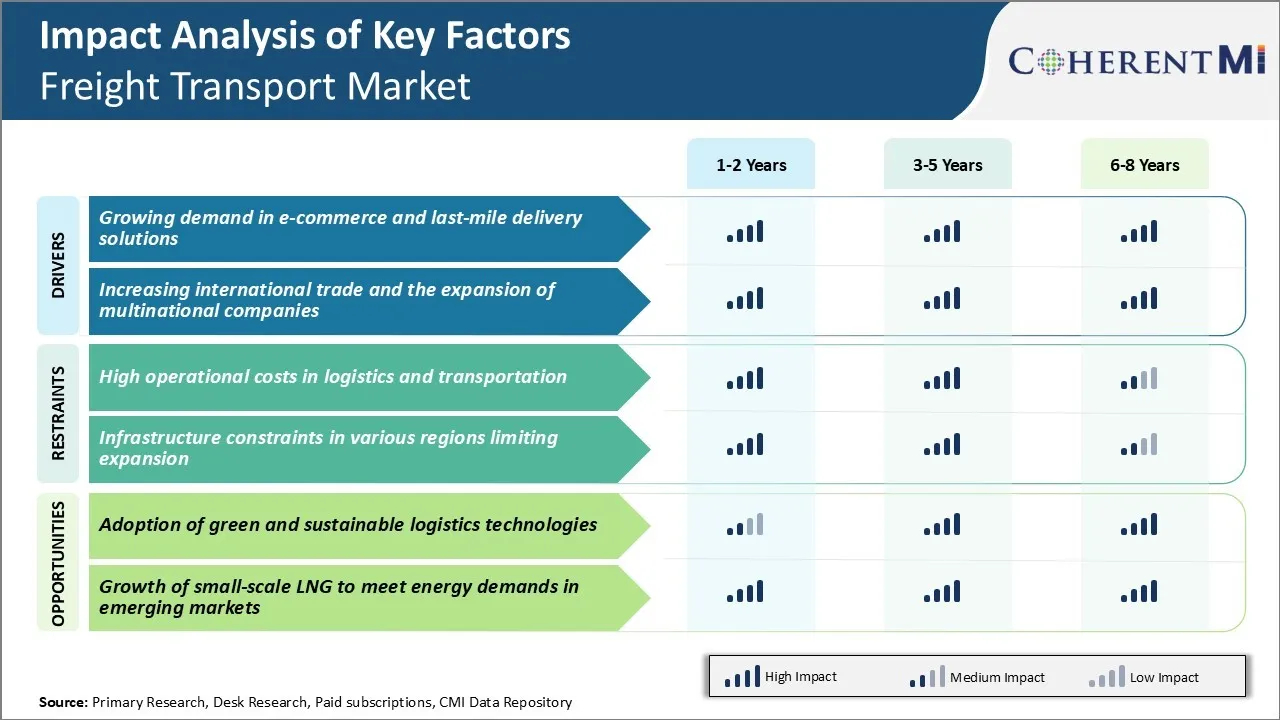Freight Transport Market Trends
Market Driver - Growing Demand in e-commerce and Last-mile Delivery Solutions
An ever-increasing number of consumers are choosing to shop online rather than in brick-and-mortar stores. Thereby, the growth of e-commerce and the resulting demand for efficient last-mile delivery solutions has had a transformational impact on the freight transport industry in recent years.
For e-commerce companies, meeting increasingly high expectations for fast, reliable delivery has become a core competitive differentiator. It is driving massive changes in the logistics and delivery landscape. As a result, there has been significant investment and innovation focused on improving and optimizing last-mile delivery operations.
New transport companies have sprung up specifically focused on providing last-mile services to leverage new technologies like electric vehicles, consolidate parcel routes. Other innovations like self-driving vehicles, autonomous delivery drones, and automated parcel lockers also aim to make the delivery process more efficient. They enable in increasing visibility and control of the overall experience.
The growth of services like buy-online pickup-in-store also reflects efforts to balance the demands of e-commerce with the practical limitations of traditional delivery models. All of these types of developments present major opportunities for firms across the freight transport market.
Market Driver - Increasing International Trade and the Expansion of Multinational Companies
Another driver supporting growth in the freight transport market has been the ongoing expansion of international trade volumes and the increasing global reach of multinational corporations. Companies set up manufacturing operations in low-cost regions to serve worldwide markets and also pursue strategic acquisitions or partnerships abroad. Consequently, international trade lanes have proliferated tremendously.
Major shipping lines have raced to add larger vessels to their fleets to capitalize on economies of scale and meet the demands of this trade boom. Most global seaborne trade are relying on just a few dozen mega shipping companies operating vast integrated networks. Similarly, air freight and trucking capacity has expanded to support the time-critical delivery needs of end-use industries.
Overall, multinational companies act as a major catalyst propelling long-term growth across the freight transport market. Whether on land, sea, or air, innovative solutions helping manage risk and coordinate shipments across vast global transportation networks will remain in high demand.

Market Challenge - High Operational Costs in Logistics and Transportation
One of the major challenges currently faced by the freight transport market is its high operational costs associated with logistics and transportation activities. Logistics costs account for a significant portion of the total operating expenses for companies across numerous industries that rely on freight transport for distribution of goods.
Factors such as rising fuel prices, driver salaries, infrastructure maintenance charges, and equipment upgrade costs have been consistently pushing up the operational expenditures for freight carriers and third-party logistics service providers. The ongoing shortage of drivers in some countries has also led to higher wage payments in order to attract and retain talent.
The high fixed costs put pressure on profit margins, especially during periods of slow economic growth when demand is subdued. Carriers struggle to remain cost-competitive while maintaining service quality standards, which poses a major challenge for players in the freight transport market.
Unless technological innovations are leveraged and new business models adopted to enhance processes, high logistics expenses will continue to pose challenges to the profitability and growth of companies reliant on freight transport.
Market Opportunity - Adoption of Green and Sustainable Logistics Technologies
One major opportunity for the freight transport market lies in stronger adoption of green and sustainable logistics technologies. With growing environmental regulations and demand for reduced carbon footprint, freight transport companies have a strong incentive to integrate clean technologies into their operations.
Adopting electric vehicles for short-haul operations, utilizing hybrid engines, optimizing routes through fleet management systems, and implementing telemetry and IoT sensors can help lower fuel consumption and emissions. Shifting a portion of land-based freight to rail and sea transport modes that are relatively more energy-efficient compared to road transport also provides opportunities.
Investing in alternate fuels like hydrogen cells and supporting infrastructure can boost energy security of carriers in the long-run. Embracing digitization through tools such as blockchain, advanced analytics, and automation additionally allows for higher visibility and optimized resource usage.
Tapping into these sustainable technologies can help companies in the freight transport market future-proof their operations. It will also facilitate to lower costs of doing business, gain a competitive advantage, and meet ESG goals of customers - capturing an emerging market trend.